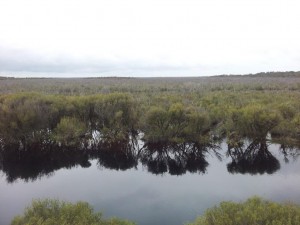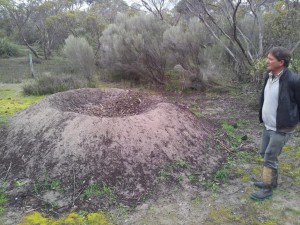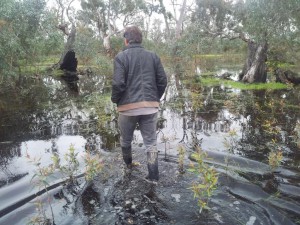A visit to Duck Island and some thoughts about strategic design
On Thursday I had the privilege of being invited to spend the afternoon with James Darling at Duck Island in the Upper South East.
James and his partner Lesley Forwood are artists, farmers and environmental managers – and have excelled over many years in all three pursuits. You might be thinking that these sound like an unusual blend of interests; yet the way they come together at Duck Island are apparent wherever you look and contribute to making this a unique, compelling place. As well as a basic principle of working with nature, the philosophical approach on display can be summed up by one simple word that James mentioned at some point in our conversation: “design”.
The notion of thinking deeply about and experimenting with innovative design really strikes a chord with me. During the course of our conversation I reflected on a presentation I attended in Adelaide a year or two ago by Dan Hill, who was visiting from the Helsinki Design Lab (a now completed project funded by Sitra – the Finnish Innovation Fund). If you are interested in the wider concept of strategic design, and how it can be applied to a range of complex (practical and/or process related) situations in all disciplines, then you may find this book or this article of interest as a starting point.
Back to Duck Island… and it turns out that after recent rainfall events in August, minor floods (a rarity in recent years) have temporarily returned to the local landscape – making it a fantastic time to look around the substantial areas of Duck Island where nature conservation is the primary land management goal.

A once-common sight in the Upper South East, now a rarity through drainage and development – inundated Melaleuca brevifolia floodplain heathland, still preserved on Duck Island.
After enjoying the wetlands of Duck Island, we checked on the progress of several Malleefowl mounds on the property – also giving me a chance to hear about James’ long-term interest in, and intimate knowledge of, these fascinating birds. In doing so, it gave an insight into one of the well-known connections between Duck Island the farm, and the art of James and Lesley. Malleefowl are great designers in their own right, and provided an inspiration for some of James and Lesley’s most stunning mallee root installations.

In Nature: James with a malleefowl mound at Duck Island – a most impressive and prominent form of design in nature; everything you see has a purpose. This mound is currently active, with organic material being worked (scratched/raked) into the mound. This material will drive the composting process required to incubate the eggs after they are laid and the mound closed over.

In Art: Malleefowl Nest 8 – Autumn
May 2001
James Darling and Lesley Forwood
10.5 tonnes mallee roots
0.85 x 5.9m
Empathy: Beyond the Horizon, Porin Taidemuseo, Pori, Finland
(from http://www.duckisland.info/display.php?id=52)
Our afternoon was rounded off with an overview of the Duck Island cattle farming operation; again notable for having a strategic goal and being well designed. Like the rest of the day, this was an educational and thought-provoking experience that I thoroughly enjoyed.
If you are interested to see further photographs of James and Lesley’s artwork, please visit their website.



